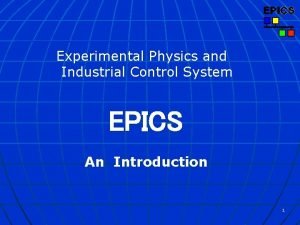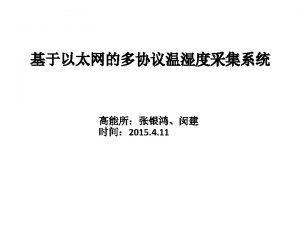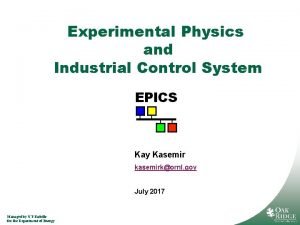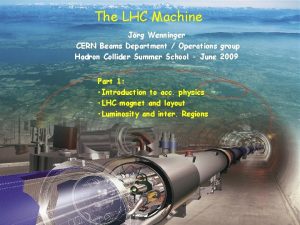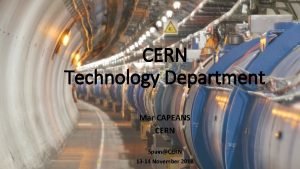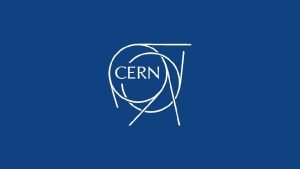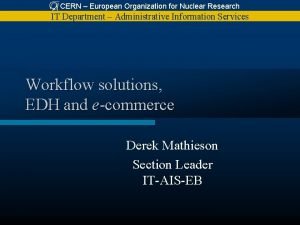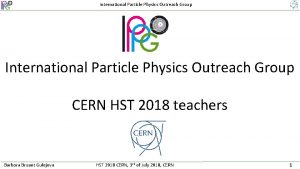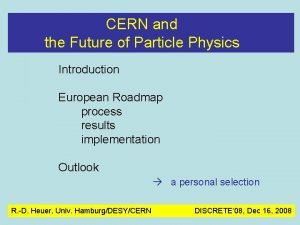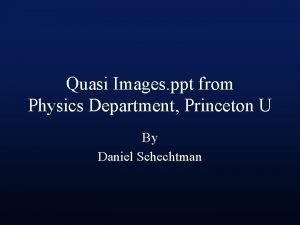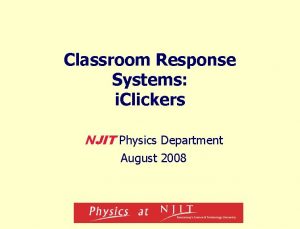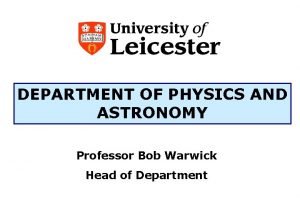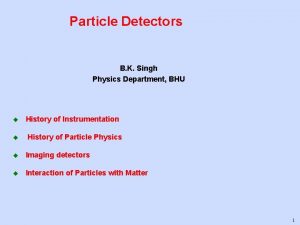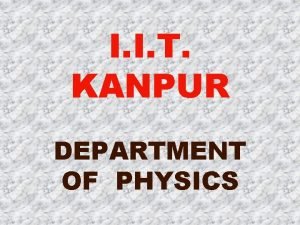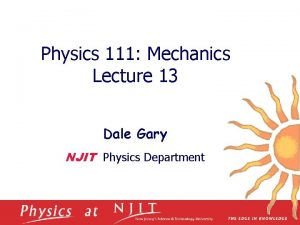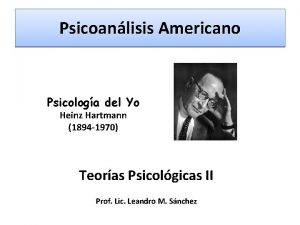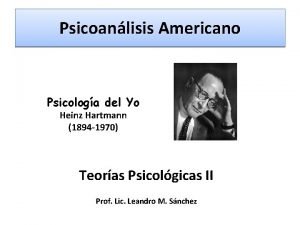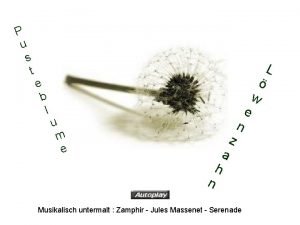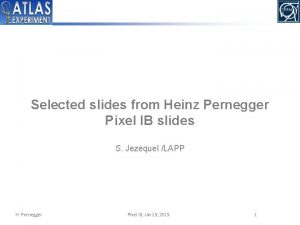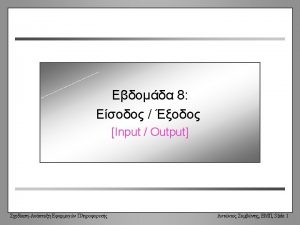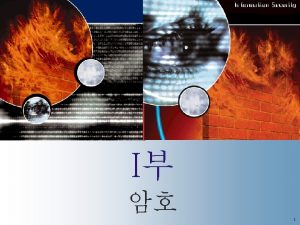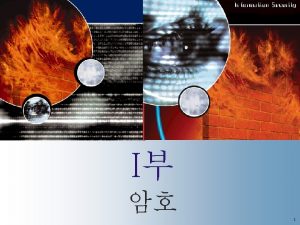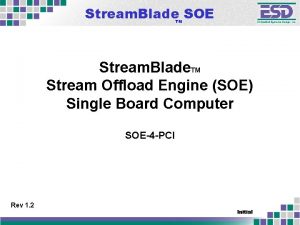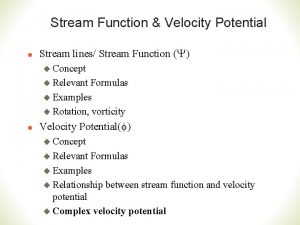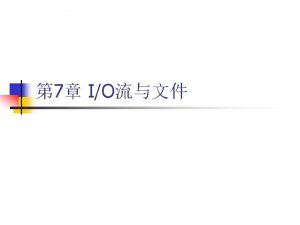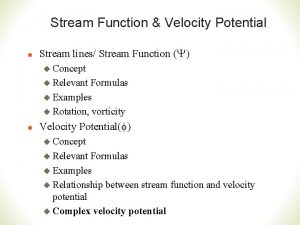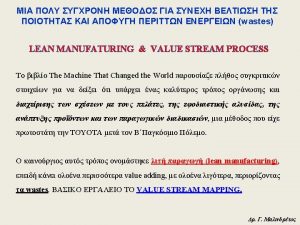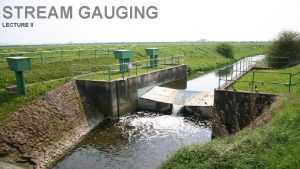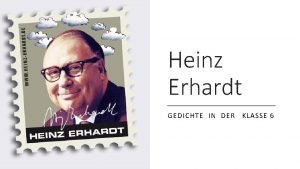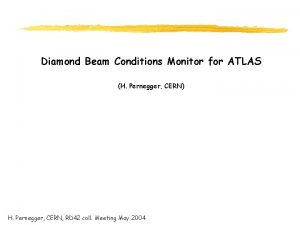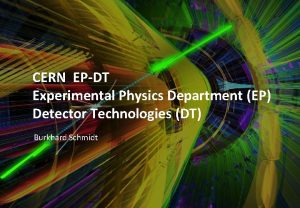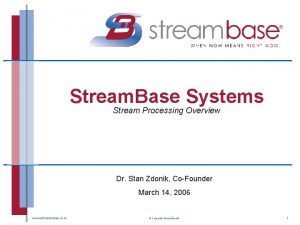STREAM Overview Heinz Pernegger Experimental Physics Department CERN


































- Slides: 34

STREAM Overview Heinz Pernegger Experimental Physics Department – CERN STREAM – Kickoff Meeting CERN 18 January 2016 H. Pernegger / CERN Smart Sensor Technologies and Training for Radiation Enhanced Applications and Measurements 18/1/2016 1

STREAM • The STREAM Project is the Marie Curie Innovative Training Network for CMOS Sensor Development in the context of LHC experiments and for selected industrial applications • It will provide research and training in the fields of – Physics – Electronics – Sensor Design – System integration • STREAM offers 17 positions for the Early-stage researchers • STREAM Website: http: //stream. web. cern. ch/ H. Pernegger / CERN Smart Sensor Technologies and Training for Radiation Enhanced Applications and Measurements 18/1/2016 2

STREAM Research and Training • The STREAM research and training program focuses on the development of radiation hard CMOS sensor technologies for innovative scientific and industrial instruments. • Interdisciplinary industry collaboration and research on key enabling technologies – Novel High Voltage (HV) and High-resistivity (HR) imaging (CIS, DMAPS) CMOS-based technologies and production processes. – Advanced design and layout for application specific CMOS-based smart sensors. – Innovative technology integration, implementation and qualification procedures • STREAM has also a special focus on dissemination, knowledge transfer and business studies. H. Pernegger / CERN Smart Sensor Technologies and Training for Radiation Enhanced Applications and Measurements 18/1/2016 3

Large Hadron Collider at CERN H. Pernegger / CERN Smart Sensor Technologies and Training for Radiation Enhanced Applications and Measurements 18/1/2016 4

Our starting point – LHC Pixel Detectors H. Pernegger / CERN Smart Sensor Technologies and Training for Radiation Enhanced Applications and Measurements 18/1/2016 5

~100 fb- PHASE 2 PHASE 0 PHASE 1 High Luminosity - LHC HL-LHC (High Luminosity LHC) ~3000 fb-1 ~300 fb-1 1 • Collisions to start mid-2026 • Maximum leveled instantaneous luminosity of 7. 5 x 1034 cm-2 s-1 HL-LHC – Currently 5 x 1033 cm-2 s-1 26 fb-1 LHC shutdown today: ~ 30 fb-1 30 cm • 3000 fb-1 Integrated luminosity to ATLAS over ten years • 200 (mean number of) interactions per bunch crossing. – Original design for 25 interactions per bunch crossing • 3 reasons to upgrade: Radiation damage, occupancy, bandwidth from front end 200 pile up event H. Pernegger / CERN Smart Sensor Technologies and Training for Radiation Enhanced Applications and Measurements 18/1/2016 6

ATLAS Phase II Tracker Upgrade radius Long Strips Barrel End cap Short Strips Pixelsbeam- I P axis Fluence estimates up to few 1016 particles/cm 2 Gives Grad (10 MGy) doses to some components z [m] Challenges facing HL-LHC silicon detector upgrades: Pixel 10 to 16 m 2 700 to ~1000 • Higher occupancies Strip 193 m 2 74 Silicon Area Channels [106] ⤷Finer Segmentation • Higher particle fluences ⤷Increase Radiation Tolerance Short Strip (2. 4 cm)(~200 -stripsm(stereo layers): 2) • Larger Area Long Strip (4. 8 cm) -strips (stereo layers): ⤷Cheaper Sensors H. Pernegger / CERN New layouts under investigation with a pixel and 15 with r = larger 38, 50, 62 cm system Upradii to 1. 2 x 10 1 Me. Vmore neq/cm 2 r = forward 74, 100 cmcoverage. Up to 5. 6 x 1014 1 Me. V neq/cm 2 • Pixel area increases to as much as 18 m 2 Smart Sensor Technologies and Training for Radiation Enhanced Applications and Measurements 18/1/2016 7

The LHC environment • Given by LHC radiation level, hit rates and bunch structure • 25 ns • L 1 trigger rate • Outer Pixel layers • • Occupancy 1 MHz/mm 2 NIEL ~ 1015 neq/cm 2 TID ~ 50 Mrad Larger area O(10 m 2) • Inner Pixel layers • • H. Pernegger / CERN Smart Sensor Technologies and Training for Radiation Enhanced Applications and Measurements Occupancy 10 MHz/mm 2 NIEL ~ 1016 neq/cm 2 TID ~ 1 Grad Smaller area O(1 m 2) 18/1/2016 8

CMOS sensors for HL-LHC CMOS technology is interesting as charged particle detectors (as well as X-ray/NIR detector) • CMOS electronics inside deep n-well (NMOS inside additional p-well): “Smart Diode Array” (SDA) • Radiation hardness : charge collection by drift combined with thin depletion zone → short drift time → little trapping by lattice defects → radiation hard (bulk) • Can sub-structure pixels to increase spatial resolution and keep noise low • thin depletion zone allows thin detectors H. Pernegger / CERN • • CMOS is much higher volume than our specialty high-resistivity planar sensors Hope achieve a significantly lower price and work on larger wafers (8 inch instead of 4 -6 inch) Smart Sensor Technologies and Training for Radiation Enhanced Applications and Measurements 18/1/2016 9

Industrial Application • Applications that require an depleted silicon sensor volume like • X-ray detection in ~10 ke. V or near infrared (photon range 2 -10 um) • charged particle detection – proton, electrons e. g. in medical applications • neutral particle detection through conversion – e. g. neutron detectors • Examples • Radiation monitoring for aeronautic and environmental applications • Electron microscopy – next generation of radiation hard high resolution sensors for highest tresolution electron microscopes • X-ray detectors for medical diagnostic and crystallography with medium energy Xray at 8 ke. V and 17 ke. V • Near Infra-red sensors (Proximity and motion sensors, medical sensors, . . ) H. Pernegger / CERN Smart Sensor Technologies and Training for Radiation Enhanced Applications and Measurements 18/1/2016 10

The STREAM challenges • Develop CMOS sensors that… – Collect charge by drift – not diffusion! – Analog designs : Demonstrated radiation hardness to high levels (1014 to 1015 to 1016 neq/cm 2) and show fast signal response (~20 ns) – Digital integration as driven by applications : Assembly to digital chip (“CCPD”) and/or integration of digital stages compatible with application specifications in monolithic sensors – System integration to detector modules using ultrafine pitch bonding and/or TSV and redistribution layers H. Pernegger / CERN Smart Sensor Technologies and Training for Radiation Enhanced Applications and Measurements 18/1/2016 11

CMOS Sensor Implementations • STREAM target the implementation of CMOS for different applications Passive CMOS sensors • Study charge collection • Passive Sensor to hybrid detector • Possible cost advantage H. Pernegger / CERN Active sensor + Digital chip • Hybrid detector for high hit rates • On-sensor Digital functionality like sub pixel encoding • CCPD hybrid detector Smart Sensor Technologies and Training for Radiation Enhanced Applications and Measurements Active Sensor with standalone readout • Thin monolithic CMOS sensor (DMAPS) • Analog stage optimization • On-chip digital readout 18/1/2016 12

STREAM Applications • • Design and production of radiation tolerant CMOS sensors scientific applications like tracking detectors at LHC and as beam monitors Develop IC to sensor ultra-fine pitch bonding process for very thin, large area ASICs as well as innovative 3 D packaging for system integration. Optimize CMOS and HV CMOS processing and design for X-ray and Near-Infrared (NIR) detection in medical, industrial, space and avionics applications and beam line instrumentation. Develop ultra-high resolution electron microscopy systems with focus on new radiation-hard sensors for very fast readout, high DQE and high dynamic range. H. Pernegger / CERN Smart Sensor Technologies and Training for Radiation Enhanced Applications and Measurements 18/1/2016 13

STREAM and CMOS Sensors • STREAM programme is designed to address the scientific goals and provide a training programme for the STREAM researchers. • STREAM research and training work packages on – CMOS Technologies Assessment – Smart Sensor Design and Layout – Validation and Qualification – Technology Integration – Valorization H. Pernegger / CERN Smart Sensor Technologies and Training for Radiation Enhanced Applications and Measurements 18/1/2016 14

STREAM work packages H. Pernegger / CERN Smart Sensor Technologies and Training for Radiation Enhanced Applications and Measurements 18/1/2016 15

WP 2: CMOS Technologies Assessment • Assess potential of advanced HV and imaging CMOS processes and test those processes H. Pernegger / CERN Smart Sensor Technologies and Training for Radiation Enhanced Applications and Measurements 18/1/2016 16

WP 2: Combine high resistivity and high voltage • We need to optimize the charge collection for – Fast charge collection to avoid trapping after irradiation – Large depletion region for high(er) signals • Substrate resistivity • High CCE Fill factor H. Pernegger / CERN Bias voltage • • • Combine HR & HV & Fill Factor to get large depleted volume with fast charge collection by drift Aim at depletion region of ~40 to 60 m Aim at ~4000 e 25 ns in-time efficient Reasonable short drift paths to avoid large trapping after irradiation Smart Sensor Technologies and Training for Radiation Enhanced Applications and Measurements 18/1/2016 17

WP 3: Smart Sensor Design and Layout • • • Pursuit designs with different fill factors • Large fill factor – Uniform charge collection – Large capacitance on CSA Small fill factor – Slower ( less uniform ? ) charge collection – Small Capacitance on CSA Input capacitance to CSA • • • Higher noise due to higher capacitance Speed effected by high C Dominated by C between p-well and deep n-well Hybrid planar ~ 100 f. F per 50 x 250 m pixel On CMOS with high FF extrapolate to ~ 200 f. F T. Hemperek, H. Krueger / Bonn H. Pernegger / CERN Smart Sensor Technologies and Training for Radiation Enhanced Applications and Measurements 18/1/2016 18

WP 3: Digital functionality on DMAPS • Why is a depleted monolithic solution attractive? – Much simpler assembly at lower cost (no more bonding!) – Thinner modules with less X 0 – Suitable for applications with medium hit rates • Different existing development can be used and are followed at the moment: Column-drain • Double column readout • Currently designed for LFoundry DMAPS (Bonn, SLAC, SC) H. Pernegger / CERN Single pixel to periphery Priority encoding • Route single pixel output to digital block on edge • AMS developments by KIT/Liverpool/IFAE • Used in new AMS 350 pixel chip • Existing readout for ALICE p. ALPIDE chip • “multiplex” pixel to digital periphery • Adaptable to Atlas Smart Sensor Technologies and Training for Radiation Enhanced Applications and Measurements 18/1/2016 19

WP 4: Validate & Qualify • Validation and Qualification using different sensor technologies, • Measure and simulate signal formation • Compare prototypes in view of different applications using lab performance evaluation, irradiation campains and beam tests • Study Operational aspects and sensor performance – imaging and tracking sensors will need to be optimized for spatial resolution, – charge collection efficiency and fast signal response – operational stability (e. g. leakage current & voltage) H. Pernegger / CERN Smart Sensor Technologies and Training for Radiation Enhanced Applications and Measurements 18/1/2016 20

WP 4: performance tests • E. g Compare expected charge collection (TCAD) to measurements in • Beams to test spatial resolution and efficiency • Lasers to probe drift vs. diffusion region 120 Ge. V Pion SPS Fe 55 ~ 1650 e- H. Pernegger / CERN Smart Sensor Technologies and Training for Radiation Enhanced Applications and Measurements 18/1/2016 21

WP 5: Technology Integration • Integration of CMOS sensors to demonstrator modules for High Energy Physics as well as for feasibility tests in electron microscopy, NIR & X-ray sensors • Research in integration methods (through-silicon-vias and redistribution layers) TSV-last + RDL Connect chip M 1 from front to back of chip • • • Flex to chip connection e. g. direct laser soldering Sensor + ROC fine-pitch bumping for hybrid detectors Flex leti FEIx H. Pernegger / CERN Sensor Stave surface Smart Sensor Technologies and Training for Radiation Enhanced Applications and Measurements 18/1/2016 22

WP 5: CMOS Modules Flex DMAPS Sensor Flex FEIx Monolithic (DMAPS) Stave surface Hybrid (CCPD or bumps) CMOS Sensor H. Pernegger / CERN Stave surface • DMAPS – Flex to chip connection by direct laser soldering – Stitching required for large size modules • Hybrid – Flex to FEIx connection by TSV-last and re-distribution layer (RDL) – Compatible with CCPD and bump-bonding – Enables the use of wafer-to -wafer bonding technologies Smart Sensor Technologies and Training for Radiation Enhanced Applications and Measurements 18/1/2016 23

W 6: Valorization Stream technologies will be analysed with regard to their potential commercial applications in cooperation with STREAM industrial partners: • Technological competence leveraging : identification and evaluation of application fields for STREAM technologies • Market studies, business model development and commercialization strategies A hands-on entrepreneurship training program will be offered to the ESRs , providing them with the opportunity to work on business cases for STREAM technologies themselves. H. Pernegger / CERN Smart Sensor Technologies and Training for Radiation Enhanced Applications and Measurements 18/1/2016 24

STREAM Training • Scientific training through common network wide training events and specific training available at partners + Ph. D courses • Complementary skill training in project management, presentation skills, language courses, preparing publications, … • Business training provided by University of Economics and Associated Partners H. Pernegger / CERN Smart Sensor Technologies and Training for Radiation Enhanced Applications and Measurements 18/1/2016 25

Network-wide training events • STREAM network wide training events will include scientific and complementary skill training H. Pernegger / CERN Smart Sensor Technologies and Training for Radiation Enhanced Applications and Measurements 18/1/2016 26

STREAM Partners H. Pernegger / CERN Smart Sensor Technologies and Training for Radiation Enhanced Applications and Measurements 18/1/2016 27

Your STREAM Team • Network Coordination – H. Pernegger <Heinz. Pernegger@cern. ch> – M. Capeans <Mar. Capeans@cern. ch> • Administation – Seamus Hegarty <Seamus. Hegarty@cern. ch> – Cecile Granier <Cecile. Granier@cern. ch> – Hanna Poikela <hanna. juujarvi@cern. ch> • Legal Advice – Karen Ernst <karen. ernst@cern. ch> • Financial Planning – Florence Pesce <stream-finance-support@cern. ch> H. Pernegger / CERN Smart Sensor Technologies and Training for Radiation Enhanced Applications and Measurements 18/1/2016 28

STREAM Partners CERN: Contacts: H. Pernegger, M. Capeans, S. Hegarty, C. Granier, H. Poikela Bonn: Contact: N. Wermes FEI: Contact: L. Mele, F. de Jong H. Pernegger / CERN Smart Sensor Technologies and Training for Radiation Enhanced Applications and Measurements 18/1/2016 29

STREAM Partners Fraunhofer IZM: Contacts: T. Fritzsch, O. Ehrmann KIT: Contact: I. Peric WU Wien Contact: P. Keinz Glasgow Contact: C. Buttar H. Pernegger / CERN Smart Sensor Technologies and Training for Radiation Enhanced Applications and Measurements 18/1/2016 30

STREAM partners Geneva: Contacts: G. Iacobucci, S. Gonzalez Sevilla Ci. S: Contact: R. Roder, T. Wittig ams: Contact: I. Jonak-Auer CPPM: Contacts: A. Rozanov, M. Barbero H. Pernegger / CERN Smart Sensor Technologies and Training for Radiation Enhanced Applications and Measurements 18/1/2016 31

STREAM Partners Liverpool: Contacts: G. Casse TU Berlin: Contact: R. Thewes INFN Milano: Contact: C. Meroni CIVIDEC: Contact: E. Griesmayer Oslo: Contact: H. Sandaker, S. Stapnes, O. Rohne H. Pernegger / CERN Smart Sensor Technologies and Training for Radiation Enhanced Applications and Measurements 18/1/2016 32

Today’s Kick-off meeting • Today’s kick-off meeting is the first occasion to meet each other and exchange ideas • The meeting will give an overview of STREAM’s research work packages and administrative procedures for the MC ITN. – – – ITN management and recruitment (S. Hegarty) Financial management (G. Cavallo) STREAM Project Office & Outreach (H. Poikela) STREAM Training Program (M. Capeans) STREAM Research Program (work package leaders) 1 st STREAM Supervisory Board H. Pernegger / CERN Smart Sensor Technologies and Training for Radiation Enhanced Applications and Measurements 18/1/2016 33

I would like to welcome you to the STREAM project and wish you a fruitful collaboration on the STREAM Marie Skłodowska. Curie Innovative Training Network! H. Pernegger / CERN Smart Sensor Technologies and Training for Radiation Enhanced Applications and Measurements 18/1/2016 34
 Differentiate byte stream and character stream
Differentiate byte stream and character stream Experimental vs non experimental
Experimental vs non experimental Quasi experimental design example
Quasi experimental design example Experimental vs non experimental research
Experimental vs non experimental research Non experimental design vs experimental
Non experimental design vs experimental Nonexperimental study
Nonexperimental study Department overview template
Department overview template Experimental physics and industrial control system
Experimental physics and industrial control system Experimental physics and industrial control system
Experimental physics and industrial control system Experimental physics and industrial control system
Experimental physics and industrial control system Cern beams department
Cern beams department Mar capeans
Mar capeans Cern hr department
Cern hr department Cern it department
Cern it department Cern it department
Cern it department Cern particle physics
Cern particle physics Cern particle physics
Cern particle physics Quasicrystals ppt
Quasicrystals ppt Njit physics
Njit physics Department of physics university of tokyo
Department of physics university of tokyo Warwick astro
Warwick astro Bhu physics department
Bhu physics department Iit kanpur physics department
Iit kanpur physics department Njit kepler
Njit kepler Michigan state physics
Michigan state physics Why does it happen
Why does it happen University physics with modern physics fifteenth edition
University physics with modern physics fifteenth edition Ib physics ia sample
Ib physics ia sample Dr. heinz lycklama
Dr. heinz lycklama Heinz dilemma
Heinz dilemma Areas libres de conflicto
Areas libres de conflicto Biografia de heinz hartmann
Biografia de heinz hartmann Rbc morphology grading guide
Rbc morphology grading guide Löwenzahn gedicht
Löwenzahn gedicht Heinz purple ketchup
Heinz purple ketchup







